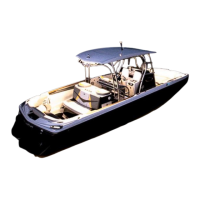PFD Accessibility
• Wearable PFDs must be readily accessible in the boat.
• It should be possible to put on the PFDs within a reasonable amount of
time in case of emergency.
• PFDs should never be stowed in plastic bags, in locked or closed com-
partments or have other gear stowed on top of them.
• The U.S. Coast Guard, as well as MasterCraft, recommends the wearing
of PFDs at all times when the vessel is underway, even though it is not a
requirement. The best PFD is the one that is worn–that is, the one that
can save your life.
• Inatable PFDs must have a full cylinder and all status indicators on the
inator must be green, or the device is NOT serviceable, and is NOT con-
sidered a usable PFD for anyone on-board the vessel.
• Coast Guard-approved inatable PFDs are authorized for use on recre-
ational boats by persons at least 16 years of age.
• Some states require children to wear PFDs at all times. Check with your
state boating safety ocials for details. Be certain to equip children with
a PFD that is appropriate for the size of the child. The label will indicate
the weight limits for use.
Sound Producing Devices
The navigation rules require
sound signals to be made under cer-
tain circumstances. Meeting, crossing
and overtaking situations, which will
be described in some detail shortly,
are examples of when sound signals
are required. Recreational vessels are
also required to sound signals during
periods of reduced visibility. Your Mas-
terCraft boat is equipped with a horn,
but you may also purchase aftermarket devices in case of potential
electrical disconnect or failure.
Note: The requirement to carry a bell on board no longer applies to
vessels operating on International Waters.
Visual Distress Signals
All vessels used on coastal
waters, the Great Lakes, territo-
rial seas and those waters con-
nected directly to them up to a
point where a body of water is
less than two miles wide, must
be equipped with U.S.C.G.-approved visual distress signals. Vessels
owned in the United States but operating on the high seas must be
equipped with U.S.C.G.-approved visual distress signals.
Pyrotechnic visual distress signals must be Coast Guard-ap-
proved, in serviceable condition and readily accessible. This means
that:
• They are marked with an expiration date. Expired signals may be
carried as extra equipment, but cannot be counted toward meet-
ing the visual distress signal requirement, since they may be unre-
liable.
• If pyrotechnic devices are selected, a minimum of three are re-
quired. That is, three signals for day use and three signals for night.
Some pyrotechnic signals meet both day and night use require-
ments.
• Pyrotechnic devices should be stored in a cool, dry location, if
possible. A watertight container painted red or orange and promi-
nently marked “Distress Signals” or “Flares” is recommended.
U.S.C.G.-approved pyrotechnic visual distress signals and associ-
ated devices include pyrotechnic red airs, hand-held or aerial; pyro-
technic orange smoke, hand-held or oating, or launchers for aerial
red meteors or parachute ares.
Non-pyrotechnic devices may be allowed. These include an or-
ange distress ag (day signal only) or an electric distress light (which
is acceptable for night use). Use of these devices must still meet Coast
Guard requirements, information for which is available online and
from the Coast Guard.
Under Inland Navigation Rules, a high intensity white light ash-
ing at regular intervals from 50-70 times per minute is considered a
distress signal. Such devices do NOT count toward meeting the visual
distress signal requirement, however. Regulations prohibit display of
visual distress signals on the water under any circumstances except
when assistance is required to prevent immediate or potential danger
to persons on board a vessel.
All distress signals have distinct advantages. No single device is
ideal under all conditions or suitable for all purposes. Pyrotechnics are
universally recognized as excellent distress signals. However, there
is potential for injury and property damage if not properly handled.
These devices produce a very hot ame and the residue can cause
burns and ignite ammable materials.
Pistol launched and hand-held parachute ares and meteors have
many characteristics of a rearm and must be handled with caution. In
some states they are considered a rearm and prohibited from use.
Check with local authorities regarding the best visual distress sig-
nal for use in the area in which you will be boating.
MasterCraft 2012 Owners Manual • Safety Knowledge • Page 1-5

